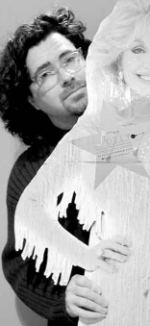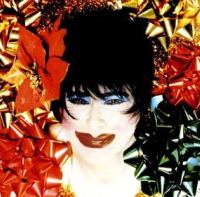Because I live in Seattle and hadn’t seen Dina Martina, I tended to lie about it. I nodded at the tottering pile of appreciation always coming her way and added mine, falsely. Grady West, who created her, is easier to know. Soft-spoken, smart and thoughtful, his ability to listen distinguishes him. If I hadn’t already known that he’s an art collector, I could have talked to him for years without finding it out. He never asked if I’d seen his show. He doesn’t look like someone who’d be at his show, the show that I hadn’t seen. (Image left, the Stranger. Image right, Seattle Times.)

 On Sunday, I became the person I pretended to be, shoe-horned into the camp locker room that passes for a theater at the Re-bar. It’s a holding tank for enemy insurgents, rimmed with pink tinsel. Said Dina, looking around with admiration: “Who doesn’t love mid-century modern?”
On Sunday, I became the person I pretended to be, shoe-horned into the camp locker room that passes for a theater at the Re-bar. It’s a holding tank for enemy insurgents, rimmed with pink tinsel. Said Dina, looking around with admiration: “Who doesn’t love mid-century modern?”
Space is limited. How much space is there for portly men impersonating glam women? Not much, and that’s where Dina begins, with nothing to prove and no apparent consciousness that such proof might be required after Divine, Leigh Bowery and Eddie Izzard; after the less-portly lovely ladies in Paris is Burning, from Pepper LeBeija and Dorian Corey to Anji Xtravaganza and Willi Ninja; after the adventures of Priscilla, Queen of the Desert.
Honey, we’ve seen it. And yet Dina Martina shines in her Goodwill high heels. Admittedly, the greatness she seeks is out of her reach. She’s more like the principal of a nursing home donning drag for the annual fundraiser. She wants to cover the world in radiance but has none to offer. She’s queen for a day on a broken TV. She’s a fish being clubbed on a pier that imagines it’s swimming free.
What is drag but over-sized desires? Although modest, Dina’s are unattainable.
Mother of an enraged teen, she wants more children. “I have child adopting hips.” She’d like to lose weight. (Her new diet, only-eat-while-driving, is working, she said, her search-light smile faltering as she looks down at her blubbery self.) Almost instantly, her demented optimism engages anew in her search for a one-true-love.
At the Re-bar, she found it. A request for hands revealed few first-timers. Dina’s been holding court at the Re-bar since 1993. In Seattle, she’s a lot like a fundamentalist church. Believers would crawl through glass to get to her. (To a Sunday afternoon crowd, she said, “Thanks for choosing me over the Lord.”)
Some jokes are chestnuts. Most are new. The show constantly renews itself without breaking new ground, except in its videos. Dina grows older, still snapping her fingers to the beat and looking for gold in dumpsters. But the videos that began as scene changers have evolved into real scenes. Dina pasted her painted fish face over Rhett Butler’s. That’s her ogling Scarlett O’Hara as the Southern beauty climbs the stairs. Dina is the new kid on the block visiting The Brady Bunch. To its lobotomized cheer she brings crazed relish. She’s Shirley Temple dancing with Bill Bojangles as American racism squirms in its seat.
The melancholy undertow rarely breaks the surface of her gay patter. For that act of bravery, for the perfect timing of her shrill songs and brazen dances, the audience continues to love her, and not just in Seattle. Dina has taken her bad act on the road, achieving success across the country, in Canada and Europe.
March 20 and 27, she’s at the Re-bar. Have a drink with her during the show (“As they teach you in AA, you can’t change anything, so why bother?”) and salute what Hunter S. Thompson called the broken chromosomes of the American dream.



Leave a Reply